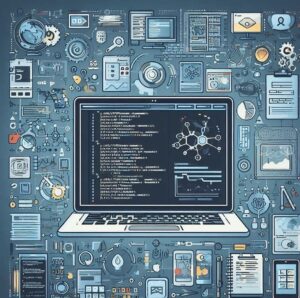Machine Learning (ML), a subset of Artificial Intelligence, involves the use of algorithms and statistical models to enable systems to improve their performance over time based on experience and data. Its application scope in mobile and desktop application development is rapidly expanding, and it is heralded as one of the key technologies driving the next revolution in computing.
Current Scenario

Machine Learning (ML) plays a significant, transformative role in mobile and desktop applications across a variety of sectors. Major tech giants like Google and Apple are no strangers to the benefits of ML, integrating it into the very fibers of their operations to enhance user experience and personalize content. Google’s search engine algorithms, for instance, continually adapt and improve based on ML, delivering an increasingly targeted and efficient user experience. Similarly, Apple’s Siri is an excellent example of ML in action, where complex voice recognition algorithms and predictive modeling contribute to a more cohesive, intuitive user interaction.
Beyond search engines or voice assistants, ML contributes to a more tailored, intuitive, and efficient user journey across Google and Apple products. The recommendations on the App Store, predictive text on keyboards, optimized battery charging, etc., demonstrate this.
The use of ML is not confined to tech behemoths. Businesses from ‘non-tech’ industries, such as finance, retail, healthcare, and more, are increasingly integrating ML into their apps. For instance, financial institutions use ML for credit scoring, minimize fraud risk, and automate investment strategies, leading to fast and more accurate decision-making. Retail businesses utilize ML algorithms to predict customer behavior, enabling them to offer personalized recommendations, optimize pricing, and manage inventory efficiently.
Healthcare apps equipped with ML provide personalized health advice and prediction based on user’s data. They can also aid in early disease detection and treatment advice, enhancing patient care.
ML also offers substantial benefits in terms of operational efficiency. By automating routine tasks, predicting performance metrics, and providing data-driven insights for strategic decisions.
The current scenario bears testament to the fact that ML is not just a futuristic concept; it’s a transformative technology being implemented here and now, shaping the landscape of mobile and desktop application development across industries.
Implications of Machine Learning in Application Development
The introduction of ML into app development has transformative implications. ML models help turn vast amounts of data into actionable insights, allowing apps to learn from user behaviors, predict future actions, and automate routine tasks. ML-powered applications offer more personalized user experiences, with features like product recommendations, personalized notifications, content curation, and proactive assistance, thereby drastically improving user engagement and satisfaction.
Machine Learning Algorithms and Tools for Development

The use of ML in mobile and desktop application development relies heavily on the effective implementation of various algorithms. Broadly, these algorithms can be classified into regression, classification, and clustering algorithms, each having distinctly different functionalities.
Regression Algorithms: regression algorithms are primarily used for forecasting and prediction tasks. For instance, in finance apps, regression can be used to forecast the future stock prices based on the historical data. In healthcare apps, it could predict potential health risks based on existing medical records and patient details.
Classification Algorithms: these algorithms categorize data into specified groups or classes based on certain characteristics. A practical application of this is in email filtering, where incoming emails are classified as ‘spam’ or ‘not spam’. In e-commerce apps, they can categorize customers into different segments for targeted marketing.
Clustering Algorithms: clustering algorithms are used to group a set of objects in such a way that objects in the same group (called a cluster) are more similar to each other than to those in other groups. Social networking apps may use these algorithms to suggest friends or groups to users based on shared interests or connections.
While these algorithms form the foundation of ML-powered application development, it’s also significant to consider the tools that facilitate their implementation.
Several platforms and software libraries have emerged that help developers to efficiently implement ML in applications. These include, but are not limited to, TensorFlow, PyTorch, and Scikit-Learn. Each of these tools has distinct advantages.
TensorFlow: google’s TensorFlow is an open-source platform that facilitates the development and training of ML models. It supports a wide range of tasks and offers robust support for neural networks. Its ability to run on multiple CPUs and GPUs and compatibility with a large number of third-party extensions makes it a versatile tool for app development.
PyTorch: developed by Facebook’s AI research lab, PyTorch is another open-source ML platform renowned for its ease-of-use and fluid computational graph. It’s particularly favored for research and prototyping due to its flexibility and speed.
Scikit-Learn: scikit-Learn is a powerful tool for Python programming language and provides efficient tools for data analysis and data mining tasks. Its comprehensive collection of ML algorithms and its simplicity make it an excellent choice for developers new to ML.
These tools not only provide pre-built functions that can be easily leveraged, but they can greatly simplify the development process and significantly reduce computation time. The resulting efficiency allows developers to focus more on tactical problem-solving, creating powerful, intelligent apps that deliver exceptional user experiences.
Case Studies
Successful integration of ML in mobile and desktop application development is evident in numerous case studies. Spotify’s personalized playlists, Gmail’s spam detection, and Facebook’s friend suggestions are all powered by ML. These companies leveraged ML to analyze user behavior effectively and provide tailor-made experiences. Despite challenges like data privacy and system compatibility, they successfully overcame them with robust security measures and efficient architecture design, leading to improved user engagement and substantial growth.
Challenges and Pitfalls
While Machine Learning (ML) is transforming a wide range of industries by offering personalized solutions, predictive capabilities, and increased efficiencies, it’s also imperative to recognize the challenges and pitfalls associated with its implementation. Various issues such as data privacy, system compatibility, computational requirements, and the ethical dimensions of autonomous decision-making can impose significant roadblocks.
In an age where data breaches are common, protecting user data is a serious concern. ML models often require access to extensive data, potentially raising privacy issues. Without proper security measures, sensitive and private user information could be at risk of being misused or compromised.
System compatibility is another key issue in ML implementation. Different systems may require different software or hardware configurations, and ML solutions must be designed to be compatible and efficient across various platforms and devices. This can be a complex task, especially across diverse and rapidly evolving technological landscapes.
ML models, especially complex ones involving deep learning, require substantial computational power. This can lead to high costs and potential delays in processing. Additionally, the use of energy-intensive computation can raise environmental sustainability concerns.
One of the fascinating aspects of ML is its ability to learn from data and make decisions autonomously without human intervention. This also presents an ethical challenge. ML models can inadvertently integrate existing biases in the data they’re trained on, leading to unfair or morally questionable outcomes. Also, with machines making decisions, it becomes difficult to attribute responsibility when things go wrong.
Despite these challenges, there are ways to navigate the pitfalls. Robust encryption technologies can secure private data, safeguarding it from unauthorized access. Optimal system design and use of cloud computation resources can address compatibility and computational issues. Rigorous testing can identify potential biases in the algorithms and mitigate unfair decision-making. And most importantly, embedding human checks and controls within the decision-making process ensures that even as ML models become ever more sophisticated and autonomous, humans retain ultimate oversight to ensure fair and morally sound outcomes.
While the use of ML does bring significant challenges, proactive planning and careful implementation can pave the way for organizations to leverage its immense benefits while mitigating potential setbacks.